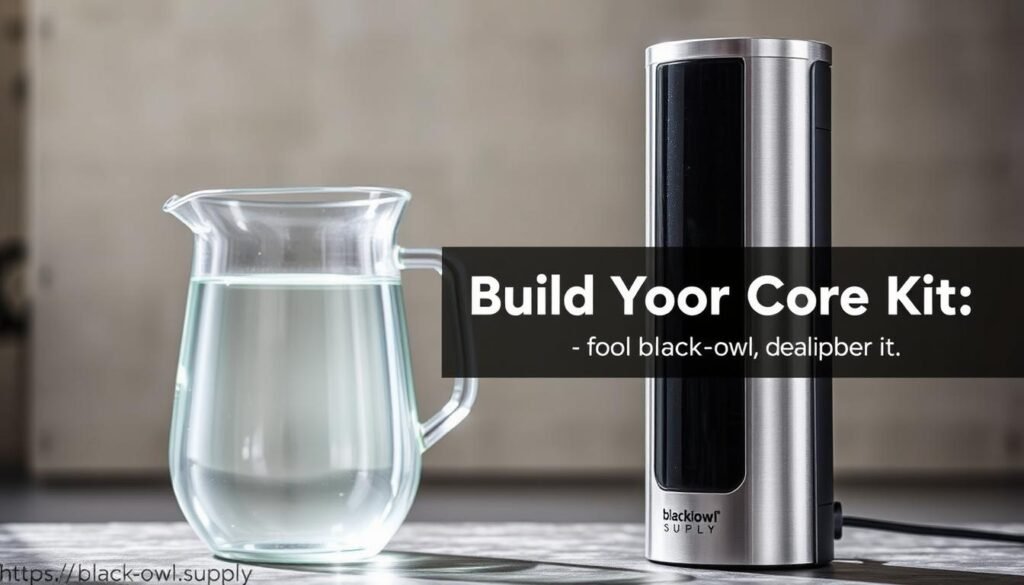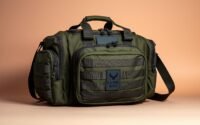Interactive Bug-Out Bag Builder – Customize for Your Region
Did you know most people can survive 72 hours with a well-packed kit, but many packs weigh so much they slow you down?
You need a plan that keeps you mobile and covers basics: water, shelter, food, first aid, and navigation. A smart bug bag should aim to weigh no more than 25% of your body weight so you can move quickly under stress.
This article walks you through building a practical kit that fits your abilities and environment. Use a clear checklist to pick essentials by category and track total weight as you add items. Whether you choose a premade kit or assemble your own, focus on mobility, adaptability, and real-world threats.
Proper planning and consideration are two keys to preparedness. Bookmark this post and return often—our advice updates as conditions and best practices change in an uncertain world.
Key Takeaways
- Pack for at least 72 hours with essentials that support survival and safety.
- Keep total weight near 25% of your body weight to preserve mobility.
- Organize items by category so you can generate a usable list quickly.
- Choose items that match your environment and likely threats.
- Start with a core kit, iterate the list, and update it over time.
Why a Bug-Out Bag Matters and How This How-To Guide Helps You Prepare
A focused 72-hour kit gives you the essentials to move from danger toward safety with confidence.
Understand the 72-hour objective: The bug bag is meant to support immediate survival and mobility during the first three days after an event. This time window covers evacuation, short-term shelter, and initial medical needs.
Match the bag to your abilities and family needs: Choose items that you can carry and use under stress. Keep an inventory at home and inside the pack so your family knows what you carry and how to help if needed.
Core planning points
- Prioritize water, food, shelter, first aid, navigation, and communication.
- Keep total weight near 25% of your body weight to preserve mobility.
- Decide whether your goal is to move to a safer location or to get home—one balanced bag can cover both.
| Attribute | Why it matters | Action |
|---|---|---|
| Mobility | Helps you travel farther and faster under stress | Limit pack weight; practice carrying load |
| Self-sustaining | Allows you to meet basic needs away from support | Include water treatment, food, and shelter |
| Adaptive | Prepares you for varied situations and weather | Layer clothing and modular items |
| Inventory | Keeps your household informed and speeds response | Maintain master list at home and inside the bag |
Take planning seriously: Reassess contents as abilities, family needs, and the world change. Bookmark this article and revisit it so your preparedness stays current.
How to Use the Builder: Get a Practical, Personalized Checklist
Pick the key survival groups first, then add items that fit your movement and space limits. Start by selecting categories like Shelter, Food and Water, First Aid, Navigation, and Communication. This helps you focus on items that will actually help survive the first 72 hours.
Select categories and generate a checklist
Choose categories and toggle items such as hydration bladders, filters, bivy or tarp options, radios, headlamps, trauma supplies, and multitools. The list groups urban and wilderness options so you can pick what fits your likely situation.
Use weight estimates to keep load manageable
The app auto-calculates total estimated weight and lets you enter your body weight to compare against the recommended 25% threshold. Watch the weight field as you add each item so your bag stays light enough for real movement.
Email and save versions
When you’re done, enter your email to receive a bug bag checklist and save multiple configurations. Keep a commute list, a weekend list, and a longer-route list so you can print a bag checklist for any situation.
| Action | Why it matters | Quick tip |
|---|---|---|
| Pick categories | Focus effort on core needs | Start with water, shelter, first aid |
| Track weight | Preserve mobility | Compare to 25% of body weight |
| Save lists | Faster response later | Email or export versions |
Proper planning and consideration are two of the more important keys in survival prep.Bookmark this post and come back frequently for updates and vetted gear options.
Customize for Your Region, Season, and Event Type
Match your packing to the places you move through daily and the likely hazards you face.
Urban, Suburban, and Wilderness Loadouts
In city settings, favor Mechanix gloves, N95 masks, safety goggles, a Stanley Wonder Bar, and a sillcock key. These items speed entry and protect hands and lungs.
On trails, choose a trekking hammock, pocket chainsaw, hatchet, compact shovel, and a small fishing kit to support wilderness survival.
Weather-Aware Packing
Pack a breathable rain shell like the Arc’teryx Beta, a tarp or poncho, and layers that match temperature swings. Manage heat with sun protection and light clothing.
Disaster Scenarios and Visibility
Map evacuation routes and plan where to shelter in place, including staying in your vehicle during severe storms. Carry a reliable radio (Eton FRX2 or Kaito KA350), a whistle, and charged phone power options.
| Situation | Key items | Why it matters |
|---|---|---|
| Urban | Gloves, pry bar, mask, goggles | Rapid access and protection in crowded places |
| Wilderness | Hammock, hatchet, fishing kit, shovel | Self-reliance and shelter in remote terrain |
| Weather-driven | Rain shell, tarp, insulation layers | Comfort and survival across temperature swings |
Proper planning and consideration are two of the more important keys in survival prep. Take them seriously. Bookmark this post and come back frequently for updated guidance.
Build Your Core Kit: Water, Food, Shelter, First Aid, Navigation, and More
Anchor your planning on a reliable core: water supplies, calorie-dense food, shelter, and first aid. Keep each item light and multi-role so your bag stays mobile and useful.

Water and purification
Prioritize a hydration bladder like a CamelBak and a durable bottle such as Klean Kanteen. Add a filter (LifeStraw or GRAYL) and Potable Aqua tablets to ensure redundancy in water purification.
Food and calories
Choose freeze-dried meals (Mountain House), compact ration bars, and energy gels (GU) to pack calories into small space. Opt for items that cook fast or eat cold to save fuel and time.
Shelter, first aid, navigation, and tools
Carry a bivy or tarp/poncho, suitable sleeping bag, and spare clothes. Stock a compact first aid kit with a tourniquet, Israeli bandage, SAM splint, and QuickClot.
Include a compass, laminated maps, an emergency radio, headlamp, multitool, fixed blade, paracord, duct tape, and zip ties. Add pepper spray and loud whistles for signaling, and document this list so you can audit your backpack and bug bag quickly.
Proper planning and consideration are two of the more important keys in survival prep. Take them seriously.
Dial in Fit, Weight, and Ongoing Readiness
Get your fit right and your weight down so the bag works with your abilities, not against them. Small adjustments to straps and load distribution cut fatigue and help you move faster when time counts.
Keep total pack weight manageable to maintain mobility
Weigh your packed bag to verify it stays near the recommended 25% of your body weight. Staying under this threshold preserves energy across varied situations and reduces joint strain.
Test your gear and practice essential skills before an emergency
Put together practice outings with your full load. Hike, start fires with backups, navigate by map and compass, and pitch shelters until setup is fast and reliable.
Seasonal updates, inventory lists, and family-specific adjustments
Refresh clothing and rotate water as weather changes. Keep a printed inventory at home and inside the bag so your family knows what you carry and who to contact.
Smart redundancies, caches on long routes, and power options
Build redundancies like a filter plus tablets without adding bulk. Consider small caches along long routes where water or food exceed what you can carry. Use a compact solar charger sparingly and prioritize tools that work without power.
Proper planning and consideration are two of the more important keys in survival prep. Take them seriously. We continually update this blog. So, bookmark it and come back frequently for the latest survival information.
Conclusion
Finish by turning planning into action: build a concise checklist you can pack and test today. Use the builder to email a bug bag checklist and a bag checklist to keep your inventory handy.
Keep weight disciplined — aim near 25% of your body weight. Prioritize water purification, shelter, first aid, navigation and a dependable radio. Choose versatile gear like duct tape and a quality multitool so each item earns its space.
Save lists for different routes and events, keep a copy at home and inside your backpack, and practice with the kit. Proper planning and consideration are two of the more important keys in survival prep. Take them seriously and bookmark this article for ongoing updates.
FAQ
What is the purpose of an emergency pack and how long should it support you?
An emergency pack is a portable set of supplies to keep you and your family safe and mobile during a crisis. Aim to support basic needs—water, food, shelter, first aid, and communication—for at least 72 hours. Tailor contents to your abilities, local hazards, and the number of people you plan to support.
How do I match my pack to my region, season, and likely events?
Start by listing regional risks—wildfire, flood, winter storms, urban outages—and pick items that address those threats. For hot climates, prioritize ventilation, hydration, and sun protection. For cold regions, add insulated layers, a winter sleeping system, and reliable shelter. Urban kits should include tools like a pry bar and sillcock key; wilderness kits need hammock, fishing kit, and hatchet.
How much should my pack weigh?
Keep pack weight manageable so you can move quickly. A good guideline is about 20–25% of your body weight for sustained travel. If you expect short moves, you can carry more; for long-distance on foot, trim nonessential items and rely on high-calorie, lightweight food and multipurpose tools.
What are the most critical water and purification items to include?
Carry a combination of a reusable water bottle or bladder, a small gravity or pump filter, and chemical purification tablets as backup. Aim for at least one liter per person on short outings and a plan to resupply via treatment for longer events.
Which food options balance weight, calories, and shelf life?
Choose compact, calorie-dense items like freeze-dried meals, energy bars, nuts, and ready-to-eat MRE-style entrees. Include a lightweight stove or fuel if you want hot meals, plus ready-to-eat options for when you can’t cook. Rotate supplies based on expiration dates.
What should a basic first aid and hygiene kit contain?
Pack essentials: adhesive bandages, sterile gauze, compression dressings, a tourniquet, antiseptic wipes, and common medications you need. Add hygiene items like hand sanitizer, a toothbrush, feminine supplies, and waste bags. Tailor trauma items if you expect higher-risk scenarios.
How do I manage navigation and communication when networks fail?
Include a battery-powered or hand-crank NOAA emergency radio, a fully charged power bank, and a tactical flashlight. Add a paper map and compass for your area and learn basic navigation skills. Consider a satellite messenger or PLB if you operate in remote wilderness.
What adaptive tools and repair items are most useful?
Bring a good multitool or fixed blade, duct tape, paracord, zip ties, and a small sewing kit. These items let you make shelter repairs, improvise fixes, and adapt clothing or gear in the field.
Should I include self-defense items and what legal concerns apply?
Self-defense options like pepper spray or a personal alarm can improve safety, but you must follow local laws. Keep items nonlethal where required, know how to use them safely, and prioritize escape and signaling over confrontation.
How often should I update and test my pack?
Inspect your pack every three to six months. Replace expired food, batteries, and medications. Test critical items—filters, radios, stoves—and practice carrying the pack on short hikes to check comfort and fit.
How can I keep multiple versions of my checklist for different scenarios?
Create scenario-based checklists—urban evacuation, wildfire, winter storm, wilderness retreat—and save them digitally. Email copies to yourself or family members and keep a printed version in a waterproof sleeve inside the pack.
What items can I cache along long routes or in a vehicle?
Cache lightweight, high-impact items like extra water treatment, a compact shelter, spare socks, a small first aid kit, and power banks. Mark cache locations and rotate supplies seasonally to avoid degradation.
How do I balance visibility with discretion in my pack choice?
Choose a pack profile suited to your environment. Bright colors increase visibility for rescue, while low-profile, muted packs reduce attention in urban settings. Match your choice to the scenario and consider removable markers or lights you can add when needed.
Can you recommend brands or products to consider?
Look for reputable gear from companies like Sawyer or Katadyn for water filters, MSR or Jetboil for stoves, Black Diamond or Petzl for lighting, and Garmin for GPS devices. For backpacks, consider Osprey, Mystery Ranch, or 5.11 Tactical depending on capacity and durability needs.
How do I account for family members, pets, and specific medical needs?
Build separate kits or modular add-ons for each person. Include pediatric supplies, prescription medications with copies of prescriptions, and pet essentials: food, leash, medication, and a collapsible water bowl. Coordinate evacuation plans and practice them together.


